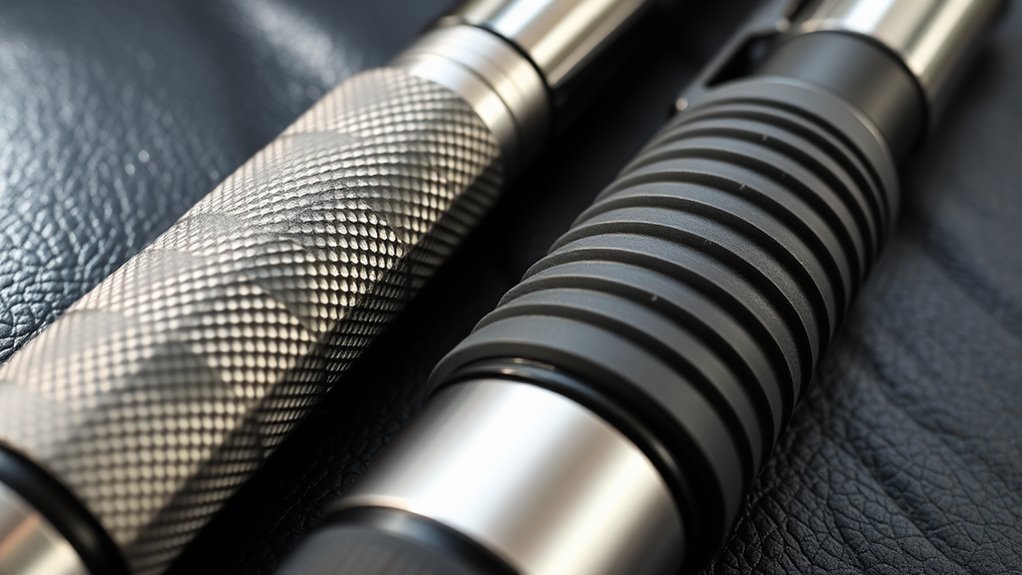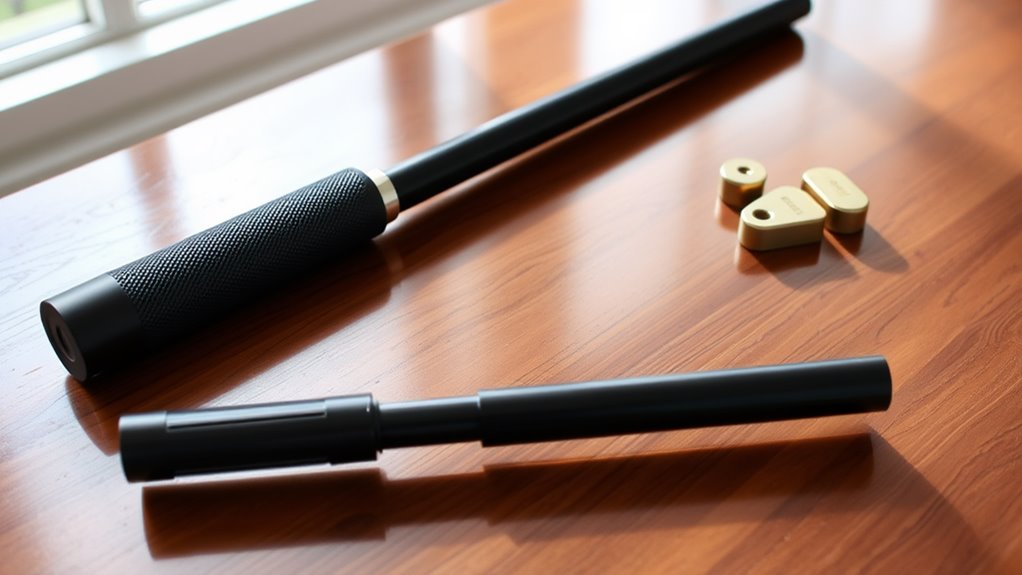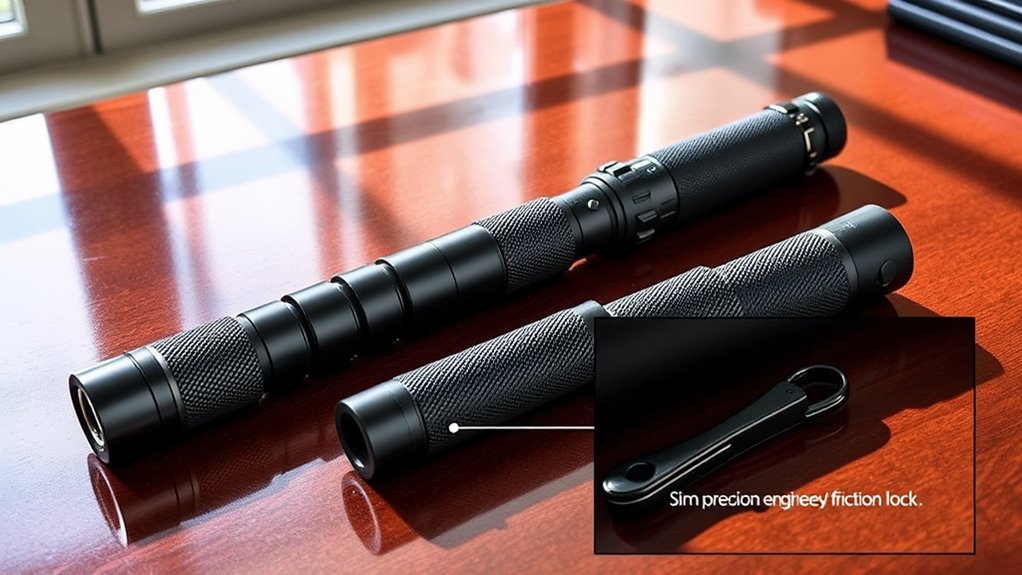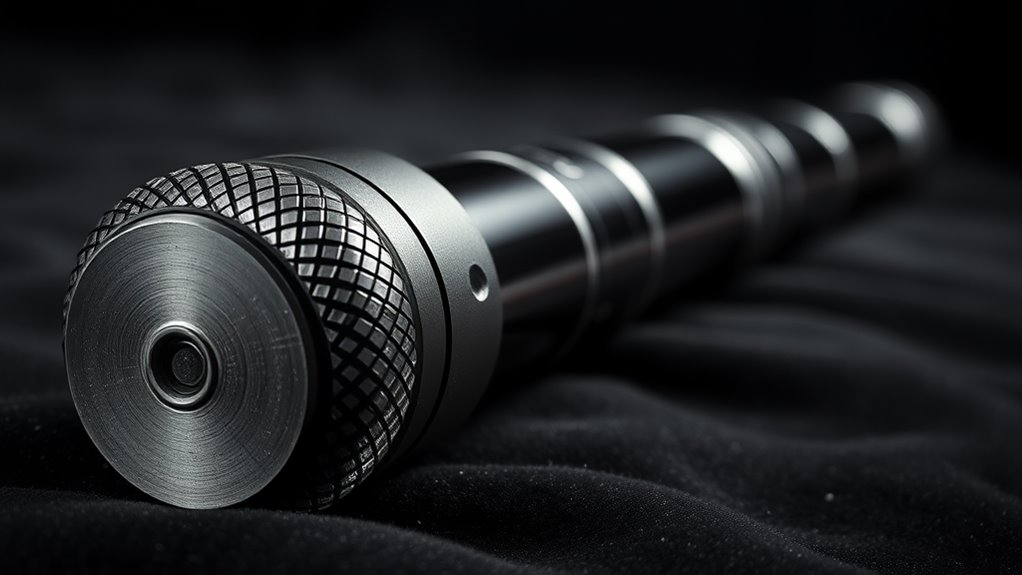Let's talk about those must-have features when picking out an extendable baton – you know, the things that really make a difference. First up, you want a grip that feels like it was made for your hand, with a nice rubberized texture that won't slip away when you need it most. Think of it like picking the perfect tennis racket – it's got to feel just right!
The length is super important too. When you extend it, it should match up with your size, kind of like finding a walking stick that's perfect for your height. For the weight, you're looking at something between 16 to 20 ounces, with most of that weight hanging out at the tip – it's like having a mini pendulum in your hand!
Now, the locking mechanism needs to be rock-solid, because nobody wants their baton doing a surprise fold-up mid-use! The collapsible part is pretty neat too – it's like having a magic wand that shrinks down when you're done with it. When it comes to materials, you're looking for the tough stuff: aircraft-grade aluminum or hardened steel, because this isn't the place to cut corners.
The strike surface should be well-designed (think of it as the business end of your baton), and when you extend it, it should pop out smooth as butter. No getting stuck halfway – that would be like having a umbrella that only opens partway in the rain! These features might seem like a lot to remember, but they all work together to give you a reliable tool you can count on when you need it most.
Grip Material and Texture

Let's talk grip materials – because nobody wants their baton flying across the room like a wayward boomerang!
The right grip can make or break your control (pun intended). Most quality batons come with either:
- Rubberized grips – comfy and secure
- Textured polymer – tough and tacky
- Ergonomic patterns – because hand cramps are no fun
You know what's worse than losing your grip? Losing it when your hands are sweaty. That's why moisture resistance is crucial – and those fancy cross-hatching patterns aren't just for show. They're like tiny superheroes fighting against slippage!
I absolutely love a grip with personality – one that's got those perfect grooves that just feel right. The rubberized coating found in some self-defense tools, such as the Runt Rechargeable Stun Gun, ensures a firm grip even in tough conditions.
And please, for the love of all things tactical, make sure it's weatherproof. Nothing's more annoying than a deteriorating grip that feels like it's melting in your hand.
Pro tip: Test the grip with slightly damp hands before buying – if it feels even slightly slippery, keep shopping. Your future self will thank you.
To ensure durability, consider materials like aircraft-grade aluminum that are used in tactical gear, which withstands harsh conditions.
Extended Length and Reach
Let's talk baton length – because size actually matters here, folks!
A fully extended baton gives you anywhere from 16 to 31 inches of reach. That's the difference between keeping trouble at bay and getting way too close for comfort. And trust me, closer isn't better in these situations!
Key points to consider:
- Match the length to YOUR body – no one-size-fits-all here
- Longer reach = better striking power (duh!)
- But too long? You'll look like a clumsy baby giraffe
- Local laws might've opinions about length (eye roll)
Think of it like choosing a dance partner – you want someone who moves with you, not against you. The perfect length lets you block, strike, and still maintain your swagger. Telescopic steel batons are available in sizes like 16, 21, and 26 inches, offering versatility for different users.
Just remember, those extra-long ones are about as subtle as a peacock at a penguin party.
Pro tip: Test your baton's extended length by holding it at arm's length – if you can't control it smoothly while moving in all directions, swallow your pride and size down.
For more options, you might consider the Automatic Expandable Steel Baton which comes in lengths of 21 inches and 31 inches.
Weight and Balance

Let's talk weight and balance – because what good is a perfect-length baton if it feels like you're wielding a fishing rod?
The sweet spot is finding something that feels like a natural extension of your arm. You want that Goldilocks moment – not too heavy, not too light, just right. Most quality batons hit the 16-20 ounce range, though your local laws might've something to say about that.
Think about it:
- Weight should concentrate at the tip when extended (hello, momentum!)
- Balance point needs to sit slightly forward of your grip
- It shouldn't feel like you're doing CrossFit just to handle it
When you extend and retract it, the motion should feel smooth as butter. No awkward wobbling or top-heavy nonsense. Nobody wants to look like they're learning to twirl a baton in marching band, right?
Pro tip: Test your baton's balance by holding it horizontally with two fingers – if it tips dramatically to either end, keep shopping.
Locking Mechanism Reliability
Let's talk locking mechanisms – they're literally your best friend when you're in action!
Two types to know about (and trust me, this stuff matters):
- Friction locks – all about that sweet internal pressure
- Positive locks – that satisfying *click* we all love
Look, maintenance isn't exactly thrilling, but it's crucial. Monthly cleaning is non-negotiable, folks.
I can't tell you how many times I've seen perfectly good batons fail because someone got lazy with maintenance. Been there, done that – learned the hard way!
Give it a few test extends and retracts. If you hear grinding (ugh, the worst), just add a tiny bit of lubricant. And please, for the love of everything, replace worn parts immediately.
Pro tip: Keep a maintenance log on your phone – future you'll be seriously grateful when you can't remember the last time you serviced your gear.
Collapsibility and Storage Design

Let's talk about collapsibility – because who doesn't love gear that practically disappears when you need it to? A solid locking system is your best friend here. When everything's working right, that baton should snap closed smoother than your favorite pocket knife.
Storage options? Oh boy, we've got choices:
- Belt clips that spin (fancy!)
- Holsters for the traditionalists
- Pouches for the tacti-cool crowd
These babies collapse down to anywhere from 6 to 10 inches – practically pocket-sized!
And trust me, you'll want something slim and snag-free. Nothing worse than drawing your baton and bringing half your uniform with it (been there, done that, got the embarrassing stories).
Pro tip: Test your baton's collapse mechanism weekly – a little maintenance now saves you from that awkward moment when it refuses to close in front of your supervisor.
Material Construction Quality
Let's talk quality, because who wants a baton that fails when you need it most? (Not me, that's for sure!)
Look, there are two materials that really matter:
- Aircraft-grade aluminum (the good stuff)
- Hardened steel (the really good stuff)
The best manufacturers put their batons through absolute hell – dropping them, striking them, and basically torturing them to make sure they're up to snuff.
Because let's face it, your baton's going to face some rough days.
Think about the weather factor too. Rain, sweat, humidity – these are all trying to turn your trusty tool into a rusty nightmare.
That's why those fancy protective coatings aren't just for show.
And don't get me started on those friction surfaces and locking mechanisms. They'd better be top-notch, or you might as well be carrying a fancy stick.
Pro tip: When testing a new baton, check the locking mechanism at least 50 times – if it starts feeling loose or sticky, run away faster than your ex at a wedding.
Strike Surface Design

Let's talk strike surfaces – they're literally the business end of any baton! Trust me, this part matters big time.
Think about it – you want that sweet spot between effectiveness and safety. A rounded tip is your best friend here, folks. Not too pointy (yikes!), not too flat (useless).
What makes a great strike surface?
- Wide enough to pack a punch
- Hardened steel that won't quit on you
- No sharp edges (because nobody wants that lawsuit!)
I've seen some truly questionable designs out there – and let me tell you, a deformed tip is about as useful as a chocolate teapot. The best ones feel just right in your hand, like that perfect coffee mug you can't live without.
Remember, we're going for that Goldilocks zone – not too aggressive, not too wimpy. Just right.
Pro tip: Always inspect your strike surface for wear after training sessions – those tiny dents or burrs you ignore today could become your worst nightmare tomorrow.
Deployment Speed and Smoothness
Let's talk deployment – because fumbling with your baton when you need it? Not cool.
You want that smooth, effortless extension that just feels right. Like butter. Or that perfect slice of pizza sliding off the pan. (Yeah, I went there.)
Quick deployment can be the difference between handling a situation and, well… not. And trust me, you don't want to be on the "not" side of that equation.
Key points to nail:
- Practice those deployment moves until they're as natural as checking your phone
- Test different techniques – downward flick, horizontal swing, whatever works
- Make sure that friction fit is just right (Goldilocks would approve)
Nobody wants a baton that sticks halfway out like an awkward handshake. Or worse, one that collapses when you least expect it. Talk about embarrassing.
Pro tip: Practice deploying while walking, sitting, and in low light – because life doesn't wait for perfect conditions, and neither should your muscle memory.
Frequently Asked Questions
Are Extendable Batons Legal to Carry in All States?
You know how every state has its own quirky rules about things? Well, extendable batons are one of those items that can get you scratching your head, wondering if you're on the right side of the law. The whole situation is kind of like trying to keep track of different house rules when you're visiting friends – what's totally fine at one place might get you in hot water at another!
Before you think about carrying one of these around, you'll definitely want to do some homework on your state's laws, since they're pretty picky about this stuff. In some places, these batons are about as off-limits as trying to bring a water bottle through airport security – they're strictly for the folks with badges only. Other states might be more relaxed about it, but they'll still have their own set of do's and don'ts.
Think of it like checking the weather before a road trip – you wouldn't want to pack flip-flops for a snowstorm, right? Same goes here: taking a few minutes to look up your local laws can save you from a whole lot of trouble down the road. The rules around these things can be as different as pizza toppings from state to state!
What Type of Maintenance and Cleaning Does an Extendable Baton Require?
Taking care of your baton is pretty straightforward, kind of like maintaining your favorite bike or tool. First off, grab a soft cloth and some light oil – nothing fancy needed here. Give your baton a good wipe-down, just like you'd polish a prized possession. Storing it is super important too – keep it somewhere dry and cozy, because rust is definitely not your friend here!
Think of regular maintenance like giving your baton a quick health check. You'll want to test how smoothly it extends, just like checking if a telescope slides out nicely. The locking mechanism needs special attention too – it's basically the backbone of your baton's reliability. Give it a few test clicks every now and then, sort of like making sure your car door closes properly.
When you're cleaning it, pay attention to any spots that might collect dust or debris. These little troublemakers can make your baton stick when you need it most, and nobody wants that awkward moment! A quick once-over every couple of weeks should do the trick, keeping your baton ready for action whenever you need it.
How Long Does a Quality Extendable Baton Typically Last With Regular Use?
A quality baton is like that reliable old friend who's always got your back, typically sticking around for 5-10 years of faithful service. Just like any good friendship, though, it needs some care and attention to stay strong! The life of your baton really depends on how often you use it and, more importantly, how well you treat it. Think of it like maintaining a bike – keep it clean, store it properly, and it'll be there when you need it.
When you're only pulling it out for occasional training sessions, kinda like that gym membership you actually use, your baton can last even longer than expected. The key is treating it like the professional tool it is, not like a toy you'd toss around. Regular maintenance is pretty straightforward, nothing fancy – just keep it clean, lubricated when needed, and stored in a dry place. It's sort of like taking care of your favorite pair of boots, except this buddy helps keep you safe!
The great thing about quality batons is that they're built tough, like those old-school Nokia phones that seemed practically indestructible. With proper care and reasonable use, you might even find yourself passing it down to the next generation of security professionals, like a family heirloom – but way more practical!
Can Extendable Batons Be Safely Used for Training and Practice?
When it comes to practicing with extendable batons, safety is your best friend, and trust me, you'll want to keep that friend close! Think of it like learning to ride a bike – you wouldn't just hop on and zip down a hill without training wheels first, right? The key is to work with someone who really knows their stuff, kind of like having a safety mentor who can show you all the proper moves and techniques.
Before you even think about swinging that baton around, you'll need to gear up properly – and no, your lucky baseball cap doesn't count as protective equipment! You'll want proper padding and protective gear, just like a quarterback suiting up for game day. It's actually pretty cool when you get all your gear on – makes you feel a bit like a safety superhero in training.
The best part about learning with an extendable baton is that you can practice in controlled environments, where there's zero chance of accidentally becoming everyone's least favorite party guest. Start slow, master the basics, and gradually work your way up to more advanced techniques. Remember, even Bruce Lee had to start somewhere, and I'm pretty sure he didn't master his moves overnight!
Just keep in mind that this isn't a game of whack-a-mole – these are serious tools that require serious attention to detail and respect. Take your time, follow your instructor's guidance, and before you know it, you'll be handling that baton like a pro – a very safe, well-trained pro!
What Certification or Training Is Recommended Before Carrying an Extendable Baton?
Getting certified to carry an extendable baton isn't as simple as just buying one and calling it a day. Think of it like learning to drive – you wouldn't hit the highway without some proper training first, right? You'll need to connect with a qualified instructor, usually someone from law enforcement or a certified security trainer, who can show you the ropes.
They'll teach you all the important stuff, kind of like learning a new dance routine but for safety. You'll practice how to smoothly pull out your baton (without accidentally whacking yourself, which happens more often than you'd think!), how to use it effectively when needed, and – super important – how to keep it secure so no one can grab it from you.
The training might feel like you're learning a whole new language at first, but don't worry – it gets easier with practice. Your instructor will walk you through different scenarios and techniques until they become second nature, sort of like muscle memory for self-defense. After all, you want to feel confident and prepared when carrying this tool, not like you're fumbling with an instruction manual in a tight spot!




